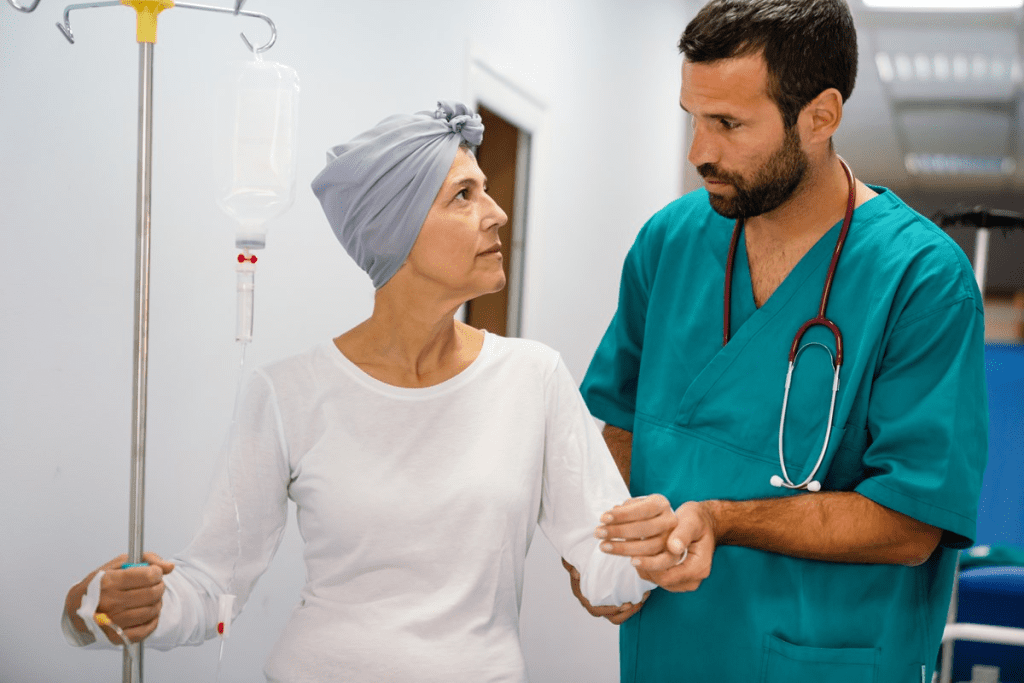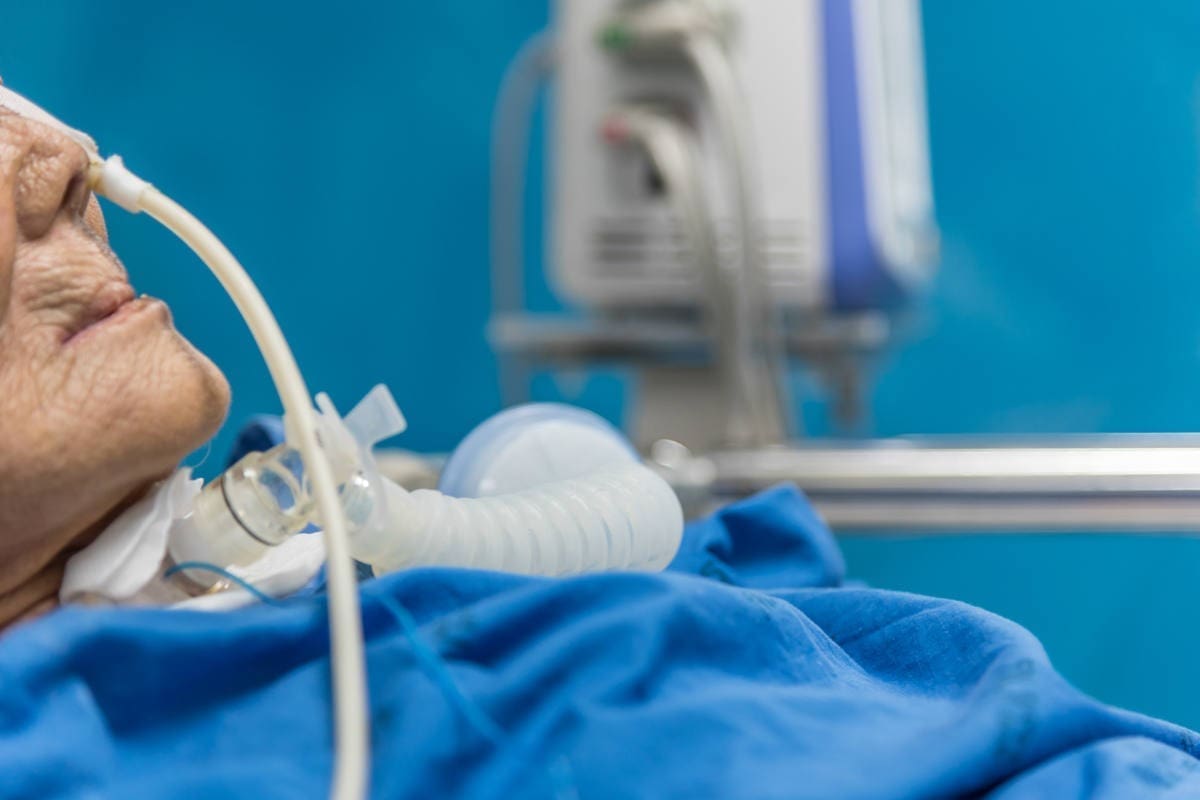Last Updated on November 26, 2025 by Bilal Hasdemir

Chemotherapy is a common treatment for cancer, with over 1 million people in the United States undergoing chemo each year. For patients and their families, knowing whether it’s effective is a major concern.
Figuring out the signs chemo is working is essential. It helps patients manage expectations and make informed decisions about their treatment plan. The success of chemotherapy depends on several factors, including the type of cancer, its stage, and the patient’s overall health.
In this article, we’ll explore the key indicators that show chemotherapy is effective and discuss why closely monitoring treatment progress is so important.
Key Takeaways
- Understanding chemotherapy effectiveness is key for patients and their families.
- Many factors affect chemotherapy’s success, like cancer type and patient health.
- Watching treatment progress helps in making smart choices.
- Chemotherapy’s success can be shown through different signs and medical checks.
- Patients should talk about their treatment plan and progress with their doctor.
Understanding Chemotherapy and Its Purpose
Chemotherapy is a key treatment for cancer. It uses drugs to kill cancer cells. This treatment can reach cancer cells all over the body.
What is Chemotherapy?
Chemotherapy uses drugs to kill cancer cells. It targets cells that grow fast, like most cancer cells. It can be used alone or with other treatments like surgery and radiation, based on the cancer type and stage.
How Chemotherapy Works Against Cancer
Chemotherapy drugs stop cancer cells from growing and dividing. They do this in different ways. Some damage the DNA of cancer cells, while others stop them from dividing. The goal is to stop cancer cells from multiplying and spreading.
“Chemotherapy is a critical component in the treatment of cancer, giving hope to patients worldwide.” –
Oncology Expert
Types of Chemotherapy Treatments
There are many types of chemotherapy, depending on the cancer type, stage, and patient health. The main types include:
- Adjuvant chemotherapy: Given after primary treatment to lower the risk of cancer recurrence.
- Neoadjuvant chemotherapy: Administered before the main treatment to shrink tumors.
- Palliative chemotherapy: Focuses on relieving symptoms and improving quality of life.
| Type of Chemotherapy | Purpose | Example |
| Adjuvant | Reduce risk of recurrence | After surgery |
| Neoadjuvant | Shrink tumors before main treatment | Before surgery |
| Palliative | Relieve symptoms, improve quality of life | For advanced cancer |
Knowing about the different types of chemotherapy helps patients understand their treatment options. It helps them make informed decisions about their care.
The Importance of Monitoring Treatment Effectiveness
It’s key to track how well chemotherapy works. This helps make better treatment choices. Knowing how well the treatment is working can greatly affect how well a patient does.
Why Tracking Response Matters
It’s important to check if the treatment is working. This lets doctors know if they need to change the plan. This info is key for deciding what to do next.
Early detection of treatment response helps make treatment better. A study in the Journal of Clinical Oncology found that checking how well treatment is working early is very important. It helps figure out how well a patient will do.
The Role of Patient Awareness

Patient awareness is very important. When patients know about their treatment and possible side effects, they can talk better with their doctors.
- Understanding the treatment schedule and possible side effects
- Noticing any changes in symptoms or condition
- Keeping a record of symptoms and side effects to talk about with doctors
Communication with Your Healthcare Team
Talking well with your healthcare team is very important. Patients should feel free to ask questions and share any changes in their health.
“Open and honest communication between patients and their healthcare providers is the cornerstone of effective cancer treatment.” –
American Cancer Society
Keeping communication open helps patients. It makes sure their healthcare team has all the info they need to make good choices about their care.
Signs Chemo is Working
Knowing if chemotherapy is working can bring comfort and motivation to patients. There are key signs that show it’s effective.
Tumor Shrinkage
One big sign is when tumors get smaller. This is seen on CT scans or MRIs. As chemotherapy kills cancer cells, tumors shrink, showing the treatment is working.
Improved Blood Test Results
Better blood test results are another sign. Some blood proteins linked to cancer go down when treatment works. This means the treatment is effective.
Reduction in Cancer Symptoms
Lessening of cancer symptoms is also a good sign. Patients might feel less pain, eat better, or have more energy. This makes life better for those getting chemotherapy.
Physical Signs Chemo is Working
When chemotherapy is effective, several physical signs show it’s working. These signs prove the body is responding well to the treatment.
Changes in Pain Levels
One key sign is a change in pain levels. As treatment progresses, patients often feel less pain. This is because tumors are shrinking or inflammation is decreasing.
This relief is a big morale booster. It shows the treatment is making a positive difference.
Energy Level Improvements
Another sign is an increase in energy levels. As the cancer burden goes down, patients feel more energetic. They can do daily tasks without feeling too tired.
This improvement may take time, but it’s a good sign. It means the treatment is helping reduce the cancer’s impact.
Weight Stabilization
Weight stabilization or gain is also a sign of effective chemotherapy. Many cancer patients lose weight unintentionally. But when treatment works, their weight may stabilize or even increase.
This is a reassuring sign. It shows the treatment is managing the cancer well.
In conclusion, signs like changes in pain, energy, and weight are important. They show chemotherapy is working. These signs, while not the only proof, give patients hope and reassurance.
Medical Tests That Measure Chemotherapy Effectiveness
Checking if chemotherapy is working involves several medical tests. These tests give important information about how well the treatment is doing. They help doctors decide if they should keep going with the treatment or make changes.
Imaging Tests
Imaging tests are key in checking how well chemotherapy is working. These include:
- CT Scans: Show detailed pictures of the body, helping to see how tumors are changing.
- MRIs: Give clear images of inside the body, useful for seeing how tumors are shrinking or growing.
- PET Scans: Use special tracers to see how active tumors are, showing if they are responding to treatment.
Blood Marker Tests
Blood marker tests check for certain substances in the blood that show if cancer is present or if treatment is working. For example:
- Tumor Markers: Proteins or molecules made by cancer cells or in response to cancer, like PSA for prostate cancer or CA-125 for ovarian cancer.
- Complete Blood Count (CBC): Shows how chemotherapy affects blood cells, like white blood cells, red blood cells, and platelets.
Biopsy Results
Biopsy involves looking at tissue samples under a microscope to see if cancer cells are there and if treatment is working. Biopsy results can show if chemotherapy has killed cancer cells or if they are left.
These medical tests together give a full picture of how well chemotherapy is working. They help doctors make the best decisions for their patients.
How Long Does It Take for Chemo to Start Working?

Many patients wonder when they’ll see the effects of chemotherapy. The time frame varies. It depends on the cancer type, treatment plan, and the patient’s health.
Initial Response Timeframes
Chemotherapy’s effects can show up in weeks or months after starting. Some see a decrease in tumor size or symptom relief in the first cycle.
Early signs of chemotherapy working include:
- Shrinking tumors
- Lessening of cancer symptoms
- Normal blood test results
Factors Affecting Response Time
Several things can affect how fast chemotherapy works. These include:
| Factor | Description | Impact on Response Time |
| Type of Cancer | Different cancers react differently to chemo | Some cancers respond quickly, while others may take longer |
| Treatment Regimen | The specific chemotherapy drugs and dosing schedule | A more aggressive regimen may yield faster results |
| Patient Health | The patient’s overall health and presence of comorbidities | Patients with fewer comorbidities may respond more quickly |
What to Expect During Different Treatment Phases
Chemotherapy is split into phases like induction, consolidation, and maintenance. Knowing what to expect in each phase helps manage expectations.
In the induction phase, the goal is to shrink tumors significantly. The consolidation phase aims to get rid of any remaining cancer cells. The maintenance phase is about preventing cancer from coming back.
Understanding these factors and what to expect in each phase helps patients better navigate their cancer journey.
Side Effects vs. Treatment Effectiveness
Many cancer patients wonder if side effects during chemotherapy mean the treatment is working. The link between side effects and treatment success is complex and often misunderstood.
Why Side Effects Don’t Always Indicate Effectiveness
It’s a common belief that side effects show how well chemotherapy is working. But, side effects do not always mean the treatment is effective. Many factors, like the type of chemotherapy and the patient’s health, affect side effects.
Some patients with severe side effects may not respond well to treatment. Others with few side effects might see a big decrease in tumor size. This shows that side effects are just one part of treatment.
Common Misconceptions About Side Effects
Many think that more severe side effects mean the treatment is better. But, the presence or absence of side effects is not a reliable sign of treatment success. Another myth is that patients with fewer side effects are not responding well.
- Side effects can vary widely among patients receiving the same treatment.
- The severity of side effects does not directly correlate with treatment outcome.
- Some effective treatments may cause minimal side effects.
When Side Effects Might Signal Treatment Response
While side effects are not a definitive sign of treatment success, they can sometimes suggest a positive response. For example, some chemotherapy drugs that cause hair loss or nausea may also fight cancer well. But, this is not true for all treatments.
Whether chemotherapy is working is decided by medical tests and evaluations, not side effects. Patients should talk to their healthcare provider to understand their treatment’s success.
Cancer-Specific Response Indicators
It’s key to know how cancer reacts to treatment for better care. Each cancer type shows its own signs of how well it’s responding.
Breast Cancer Response Signs
Breast cancer’s treatment success can be seen in changes to tumor size and lymph nodes. Doctors also watch a patient’s overall health closely. This helps them make the right treatment changes.
Lung Cancer Response Signs
Lung cancer’s treatment success is often shown by smaller tumors on scans. Patients also feel better, with less coughing or shortness of breath.
Colorectal Cancer Response Signs
Colorectal cancer’s treatment success is checked through scans and blood tests. A smaller tumor or lower levels of certain proteins in the blood are good signs.
Lymphoma and Leukemia Response Signs
Lymphoma and leukemia’s treatment success is seen in blood tests and bone marrow biopsies. Better blood counts and fewer cancer cells mean treatment is working.
How Doctors Evaluate If Chemotherapy Is Working
Doctors have different ways to check if chemotherapy is working well. They often use the Response Evaluation Criteria In Solid Tumors (RECIST).
Response Evaluation Criteria (RECIST)
RECIST helps doctors see how treatments are doing. They look at how much the tumor size has changed.
Complete vs. Partial Response
If the tumor goes away, it’s called a complete response. If it shrinks but doesn’t disappear, it’s a partial response.
Progressive Disease vs. Stable Disease
Progressive disease means the tumor is getting bigger. Stable disease means the tumor size hasn’t changed much.
Signs Chemo May Not Be Working
Knowing when chemotherapy isn’t working is key. It helps patients and doctors decide if they should keep going or try something new.
Physical Signs of Treatment Resistance
When chemo isn’t effective, you might notice some physical signs. These include:
- Increased tumor size or new tumors
- Worsening symptoms like pain, fatigue, or trouble breathing
- Weight loss or loss of appetite
Watching these signs closely is important. It helps catch when treatment isn’t working early on.
Test Results Indicating Progression
Regular tests are key to seeing if chemo is working. If the results show treatment isn’t effective, you might see:
| Test Type | Indicators of Progression |
| Imaging Tests (CT, MRI, PET) | Increased tumor size, new tumors, or increased metabolic activity |
| Blood Marker Tests | Elevated levels of tumor markers |
| Biopsy Results | Presence of cancer cells, indicating treatment resistance |
These tests give important info on how well the cancer is responding to chemo.
When to Discuss Alternative Treatments
If you see signs of treatment resistance or progression, talk to your doctor. They can suggest:
- Changing the chemotherapy regimen
- Exploring targeted therapy or immunotherapy
- Considering palliative care to manage symptoms
Open communication with your healthcare team is key. It helps find the best next steps.
Patient Experiences: Recognizing Treatment Response
Patients on chemotherapy often see small changes that show if the treatment is working. These personal stories offer valuable insights into treatment success.
Real-life Indicators Patients Have Noticed
Many patients feel better overall, which shows chemotherapy is effective. They might notice more energy or less pain.
- Increased energy levels
- Reduced pain or discomfort
- Improved appetite
These signs are important for understanding treatment progress.
Subtle Changes That May Be Meaningful
Small changes can be big signs of treatment success. These might include easier daily activities or fewer cancer symptoms.
Examples of subtle changes include:
| Symptom | Change |
| Fatigue | Slightly increased energy |
| Pain | Reduced frequency or intensity |
| Appetite | Improved or stabilized |
Distinguishing Between Treatment Effects and Cancer Symptoms
Telling treatment effects from cancer symptoms can be hard. But, it’s key to understanding treatment success.
Patients should discuss any changes with their healthcare provider to understand what they’re feeling.
By noticing these changes and talking to doctors, patients can better understand their treatment’s impact.
Questions to Ask Your Oncologist About Treatment Effectiveness
It’s important to know how well your chemotherapy is working. Asking the right questions helps you make smart choices about your health. Talking openly with your oncologist is key during your treatment.
Key Questions Before Starting Treatment
Before starting chemotherapy, there are important questions to ask your oncologist. This helps you get ready for what’s coming.
- What are the goals of my chemotherapy treatment? Knowing if it’s to cure, control, or ease symptoms is vital.
- What are the possible side effects, and how can they be managed? Knowing what to expect can help you prepare and feel less anxious.
- How will we measure if my treatment is working? This might include scans, blood tests, or other checks.
Questions During Treatment
During chemotherapy, your questions and worries might change. Here are some important ones to think about:
- How often will I need to come in for treatment, and what can I expect during these visits? Knowing the schedule helps you plan.
- Are there any symptoms or side effects I should report right away? Telling your oncologist quickly can help a lot.
- How will we know if the treatment is working, and what criteria will we use?
Questions About Test Results
Understanding your test results is key to knowing how well your treatment is working. Ask these questions:
- What do my test results say about my cancer right now? This helps you know if the treatment is effective.
- How often will I need tests, and what kinds will they be? Regular checks are important to track your progress.
- Will my treatment plan change based on my latest test results? Your treatment might need to adjust as it goes on.
“The most important thing is to never stop questioning. Curiosity has its own reason for existence.” – Albert Einstein
Discussing Next Steps Based on Response
Talking about what’s next with your oncologist is important as your treatment goes on. You might ask:
- What’s next if my treatment is successful? Planning for the future is a big part of getting better.
- If the treatment isn’t working as hoped, what other options are there? Knowing your choices helps you feel more in charge.
- How will we decide when it’s time for a different treatment or to change the current plan? Keeping an eye on how things are going is key.
By asking these questions, you can understand your treatment better and make informed choices. Remember, your oncologist is there to support you every step of the way.
Conclusion
Knowing if chemotherapy is working can give patients hope and reassurance. They can look for physical signs, check medical test results, and watch for specific cancer responses. This helps them understand their treatment better.
How well chemotherapy works depends on many things. These include the type of cancer, the stage of treatment, and how the body reacts. It’s important to keep track of how treatment is going and talk openly with doctors.
When patients and their families know the signs of chemotherapy’s success, they can feel more positive. They see that their hard work is helping them get better. By being active and involved in their care, they can increase their chances of a good treatment result.
FAQ
What are the signs that chemotherapy is working?
Signs that chemotherapy is working include shrinking tumors and better blood test results. You might also see a decrease in cancer symptoms and changes in pain levels. Improvements in energy and stable weight are also signs.
How long does it take for chemotherapy to start working?
The time it takes for chemotherapy to work varies. It depends on the cancer type, treatment phase, and how you respond. It can take a few weeks to several months to see results.
Do side effects indicate that chemotherapy is working?
Side effects don’t always mean chemotherapy is working. While some side effects can be good signs, they can also happen without treatment being effective.
What medical tests are used to measure chemotherapy effectiveness?
Tests to measure chemotherapy effectiveness include imaging tests like CT scans and MRIs. Blood marker tests and biopsy results are also used.
How do doctors evaluate if chemotherapy is working?
Doctors use Response Evaluation Criteria (RECIST) to check if chemotherapy is working. They look at complete vs. partial response and stable vs. progressive disease. They also follow specific protocols.
What are the signs that chemotherapy may not be working?
Signs that chemotherapy may not be working include physical signs of resistance. Test results showing progression and no improvement in symptoms are also signs.
How can patients recognize treatment response?
Patients can notice treatment response by looking for subtle changes. These include better energy, reduced pain, and stable weight. Talking to your healthcare team is also important.
What questions should patients ask their oncologist about treatment effectiveness?
Patients should ask their oncologist important questions before, during, and after treatment. This includes discussing test results and what to do next based on the response to chemotherapy.
Are there different response indicators for different types of cancer?
Yes, different cancers have specific signs of response. For example, breast, lung, colorectal, and lymphoma/leukemia cancers have their own indicators. These help patients and doctors understand how well treatment is working.
Can chemotherapy be effective even if side effects are minimal?
Yes, chemotherapy can be effective even with minimal side effects. The presence or absence of side effects doesn’t directly show if treatment is working.
References
- National Cancer Institute (NCI). (2023). Tumor Response to Treatment. https://www.cancer.gov/about-cancer/treatment/types/chemotherapy






